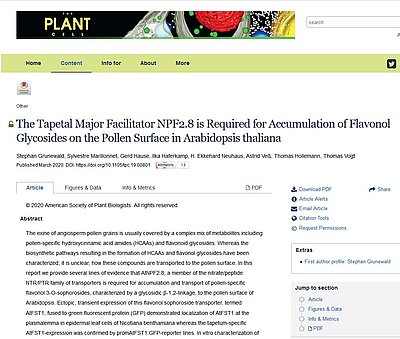Pollen Surface Replenished: A tapetal flavonoid transporter in Arabidopsis.
IPB researchers have now identified a gene encoding for a transporter responsible for translocating flavonoid glycosides to the surface of Arabidopsis pollen. A complex mix of small molecules termed the pollenkitt or tryphine usually covers the rigid pollen wall of flowering plants. This blend of proteins, sugars, waxes, peptides, and flavonoids, serves to attract pollinators and to protect mature pollen grains from pathogens but also from drought, heat, or light stress. While for some pollenkitt compounds, transport processes from the tapetum to the outer pollen wall were already known, the transporter for pollen-specific flavonoid glycosides remained enigmatic. Their findings reveal that in mutant plants deficient in FST1, the two flavonoid β-1,2-linked glycosides (sophorosides) detected on the pollen surface were drastically reduced in comparison to the wild type. The scientists demonstrated the specificity of the tapetal transporter for flavonoid glycosides and named it FLAVONOL SOPHOROSIDE TRANSPORTER 1 (FST1).
They confirmed the activity of FST1 by functional complementation of the mutant as well as transport assays with labelled flavonoids, and localized FTS1 to the plasma membrane of tapetal cells. In the future, the biological relevance of FST1 and pollenkitt flavonoids for fecundity and stress tolerance of the pollen grains will be investigated.



